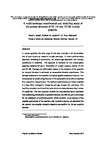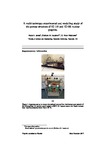A multi-technique experimental and modelling study of the porous structure of IG-110 and IG-430 nuclear graphite
| dc.contributor.author | Jones, Katie Louise | |
| dc.contributor.author | Laudone, Giuliano Maurizio | |
| dc.contributor.author | Matthews, Peter | |
| dc.date.accessioned | 2017-12-11T13:44:57Z | |
| dc.date.issued | 2018-03 | |
| dc.identifier.issn | 0008-6223 | |
| dc.identifier.issn | 1873-3891 | |
| dc.identifier.uri | http://hdl.handle.net/10026.1/10403 | |
| dc.description.abstract |
© 2017 Elsevier Ltd In nuclear graphite, the wide range of void sizes precludes a full characterisation of pore volume by means of a single technique. A novel multi-technique approach, consisting of pycnometry, low pressure gas adsorption and mercury porosimetry is presented. The approach is validated for two nuclear-grade graphites designed for use in Generation IV nuclear reactors, namely IG-110 and IG-430. Damage and deformation caused to the structure of the graphite by mercury intrusion is estimated by consecutive intrusion experiments. The damage is assumed to be caused by the highest applied pressures of mercury. It is compensated by substituting that part of the percolation curve with one derived from adsorption measurements. The various measurements are inverse modelled in a way which intelligently bridges the size gap between the techniques. The resulting complete non-hierarchical pore structure covers sizes spanning 4 orders of magnitude. The new approach resolves the long standing issues associated with performing porosimetry on graphitic samples, and fills the gap in knowledge for the assessment of multilevel porosity within graphite. As an example of the possible applications of the resulting void network structure, we calculated the air network flow capacity, related to absolute permeability, for the two graphite samples. | |
| dc.format.extent | 1-11 | |
| dc.language | en | |
| dc.language.iso | en | |
| dc.publisher | Elsevier | |
| dc.title | A multi-technique experimental and modelling study of the porous structure of IG-110 and IG-430 nuclear graphite | |
| dc.type | journal-article | |
| dc.type | Journal Article | |
| plymouth.author-url | https://www.webofscience.com/api/gateway?GWVersion=2&SrcApp=PARTNER_APP&SrcAuth=LinksAMR&KeyUT=WOS:000418479900001&DestLinkType=FullRecord&DestApp=ALL_WOS&UsrCustomerID=11bb513d99f797142bcfeffcc58ea008 | |
| plymouth.volume | 128 | |
| plymouth.publication-status | Accepted | |
| plymouth.journal | Carbon | |
| dc.identifier.doi | 10.1016/j.carbon.2017.11.076 | |
| plymouth.organisational-group | /Plymouth | |
| plymouth.organisational-group | /Plymouth/Faculty of Science and Engineering | |
| plymouth.organisational-group | /Plymouth/Faculty of Science and Engineering/School of Geography, Earth and Environmental Sciences | |
| plymouth.organisational-group | /Plymouth/REF 2021 Researchers by UoA | |
| plymouth.organisational-group | /Plymouth/REF 2021 Researchers by UoA/UoA07 Earth Systems and Environmental Sciences | |
| plymouth.organisational-group | /Plymouth/Users by role | |
| plymouth.organisational-group | /Plymouth/Users by role/Academics | |
| dcterms.dateAccepted | 2017-11-25 | |
| dc.rights.embargodate | 2019-11-28 | |
| dc.identifier.eissn | 1873-3891 | |
| dc.rights.embargoperiod | Not known | |
| rioxxterms.versionofrecord | 10.1016/j.carbon.2017.11.076 | |
| rioxxterms.licenseref.uri | http://www.rioxx.net/licenses/all-rights-reserved | |
| rioxxterms.licenseref.startdate | 2018-03 | |
| rioxxterms.type | Journal Article/Review |



